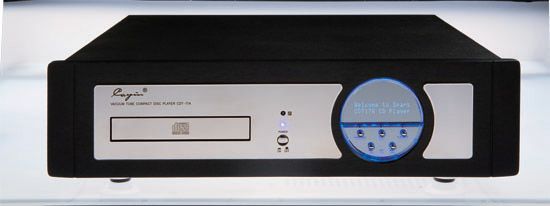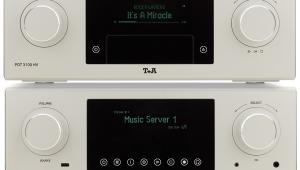Cayin Cdt 17a (£1999)

Ever since the introduction of the compact disc format – the early 1980s, if you can remember so far back – audio perfectionists have argued there’s something ‘not quite right’ about the fidelity of sound it produces.
The fact is, despite CD’s finite resolution capability, we’ve all got at least a few discs in our collections that blow our socks off. Wouldn’t you agree? Nevertheless, to tweak its sound, to ensure that CDs sounded more organic and less matter-of-fact, specialist manufacturers far and wide have long experimented with various digital filter implementations and designed proprietary analogue output stages for their players in an attempt to sweeten the sound of what analogue lovers disparagingly refer to as ‘digititus’.
The first to make a CD spinner with high-end pretentions that employed valves in its output stage was California Audio Labs. Almost three decades later, there are myriad specialist CD player manufacturers using them, intent on reproducing that ‘magical richness’ in the midrange so typical of valve electronics. To be fair, most of these are manufacturers of valve amplifiers too. ’Cos if you’re a devotee of the thermionic vacuum tube, chances are you wouldn’t give house room to anything else.
A BETTER PURSUIT
One such brand is Cayin, whose products are designed in Germany by Cayin Audio Distribution GmbH and built in China by the Zhuhai Spark Electronic Equipment Company that makes OEM audio products for several companies in Hong Kong, Japan and Europe. Based in Guangdong Province it’s a massive manufacturing facility that was spun off in 2005 from China’s government-owned CATIC group which produces, ahem, military weapons and the like. Becoming independent from CATIC and focusing entirely on the manufacturing of specialised high-end electronics for audio purposes – bringing to the world the joy of listening to music reproduced with high fidelity – is a pursuit far more worthwhile than building arms, I’m sure you’ll agree. The point is, Spark Electronic is accustomed to manufacturing to military specifications rather than cottage industry, assembled-in-a-shed standards. So forget any preconceptions you may harbour of shoddy goods made on the cheap – of mutton dressed as lamb.
Cayin’s products are hardly cheap, but neither do they come with ultra-high-end price tickets. Take a look at UK distributor Audio Sanctum’s website and if you’re a fan of gear with a 1960s/’70s look you’ll simply adore the styling of Cayin’s ‘Retro’ series of components, such as its £1450 SP-CD300 player and £1700 SP-10A integrated amp, redolent of the era in Leak-style wooden sleeves. They claim not just to look like products from a bygone era but sound like them too – ‘rich, smooth and warm’ – the 2x30W SP-A10 employing four 6L6 power valves in its output stage.
UNDER THE LID
As an example of its more standard-looking components, this Cayin CDT-17A player certainly looks nicely put together. Removing the bonnet reveals a disc transport mechanism sited in a separated sub enclosure/chamber designed to provide a degree of isolation from external vibration, light and ingress of dust – the player’s disc loading tray closing automatically if left open for more than a minute.The circuitry is laid out neatly on one multi-layered printed circuit board populated with many high quality components of the type more often reserved for extremely expensive high-end products. Pricey Japanese Nichicon electrolytic capacitors are in abundance, output coupling capacitors are the well-respected German-made Wima types bypassed with smaller value Realcaps, with more Realcaps littered about the circuit in places that the designers must have deemed critical for sound quality.
While the Cayin’s 14mm thick fascia of satin brushed aluminium, chrome overlay and sturdy 2mm thick steel chassis sitting on machined feet (with rubber pads) make the whole pretty substantial, much of the player’s 16kg weight can be attributed to its two potted toroidal power supply transformers – individual transformers for the digital and analogue sections. Digital processing is achieved with two Burr-Brown PCM1792 (24-bit/192kHz capable) digital-to-analogue converters operating in balanced mode, the CDT-17A’s output stage featuring four Russian 6922 Electro Harmonix twin-triode valves. The player’s mute function (via the handset) employs relays at the output.
As you can see in our photographs, the front panel sports a circular display/function window that’s highlighted with a blue halo illumination. Fear not if you consider it a little garish for relaxed listening in subdued lighting, as the blue halo can be switched off via the remote and the display readout can be dimmed too – although not turned off entirely. More distracting is the wickedly intense blue ‘power on’ LED above the on/off button in the centre of the fascia that continues shining across the room like a laser pointer even when the display has been dimmed.
Supplied with the CDT-17A is a rugged remote control handset machined out of aluminium that’s a cut above the traditional plastic fare dished out with many CD players. There’s nothing inspirational about its design mind you: it’s covered with rows of identically-sized buttons, so one needs to become attuned to the layout. But at least the main disc transport controls are clustered in the centre and the buttons have a pleasingly tactile ‘click’ feel to them. Moreover, the handset’s ten numbered buttons provide direct track access in the best possible fashion. Disc navigation, skipping from track to track, is pretty rapid too.
It’s a lovely player to use. I found only one operational quirk: direct track access from the open tray position only works up to track number nine! So if you wanted to go directly to, say, track 14 on a chosen CD, you must first allow the tray to close and wait for that disc’s TOC to be read before subsequently pressing keys 1 and 4 in quick succession.
Note that there’s no power on/off button on the RCU to put the player into standby. Power consumption is 30W, so you’re encouraged to switch the CDT-17A off before retiring for the night.Toujours la Politesse
I used Nordost Tyr interconnect cables, one pair with RCAs the other with XLRs, to hook up the Cayin to my Mark Levinson No.383 amplifier. And yes, the balanced connection did sound a little tighter and more precise. ‘Throw Down the Sword’ from Argus: Through The Looking Glass by Martin Turner’s Wishbone Ash [Mystic Records MYS CD 201] seemed to possess slightly better order with increased clarity between bass guitar and kick-drum when switching from single-ended to balanced connection. Subjectively, the tonal balance appeared a tad leaner; however, the fruity texture and resonance of Turner’s bass guitar was more clearly described and the sound was more open and airy.
All subsequent listening was done using the balanced outputs, as I observed a similar increase in resolution when playing ‘So Real’ from the late Jeff Buckley’s 1994 classic Grace album [Sony 4759285]. It really did sound more real, reducing what appeared to be a rather spongy and overblown lower-midrange character to this player and delivering more of that indefinable something that makes a recording sparkle and raises the hairs on the back of your neck.
After spending a few days exploring numerous CD favourites I had to conclude that this was a rather polite-sounding player: one that could be described as well-mannered and easy on the ears, yet perhaps too polite for some tastes.
Transient dynamics could have been more assertive, the CDT-17A’s spongy character being revealed when listening critically to known audiophile reference recordings such as Sheffield Lab’s wham-bam James Newton Howard And Friends [Sheffield Lab CD-23]. While there was immense weight and extension to the low-end punches of the bass riff that opens ‘Gone Buttlefishin’’, the piercing thwacks of the drums – that sharp snap of the skins that can make you wince when played at high sound pressure level – was a little soft around the edges. The tonality was lovely, as was the depth of image and sense of space around the instruments, but it seemed slow on its feet, lacking speed and agility.
Play a less dynamic and razor-sharp recording, something from the run-of-the-mill pop/rock canon such as the Eurythmics’ Sweet Dreams (Are Made Of This) [RCA 71471] and the Cayin sounds bold and rich in colour. Where the sound balance usually appears icy cold, with Annie Lennox’s voice sounding brittle, with a pinched, hard-edged character on most of the tracks, the CDT-17A’s gentle demeanour and softer edge made for wholly enjoyable listening.
The pumping rhythms of the title track with its amalgam of metronomic synthesizer lines and soulful R&B overtones were full-bodied and highly infectious, and on ‘Love Is A Stranger’ the hypnotic Kraftwerk-esque techno-pop beat and inventive production was nicely exposed, as layer-upon-layer of sound effects within the recording were laid bare across the image.
SHEER ELEGANCE
There’s a demure elegance in the way this player presents music. Whether it was a slow and soulful Clapton blues, more aggressive John Lee Hooker or utterly visceral Stevie Ray Vaughan thrash-guitar workout, the Cayin always succeeded in drawing me into the musical event.It might not offer the last word in detail retrieval and timing precision, and if you crave tight, visceral transient attack and pin-sharp image focus you might feel short-changed. But if you find too many CDs in your collection simply sound hard and aggressive – if the balance of your system makes you acutely sensitive to ‘digititus’, in other words – the Cayin will prove a delight. And that’s not to mention its highly saturated tonal colours and sweet treble combined with plenty of weighty bass muscle.
VERDICT
The last world in CD replay? Of course not. Nonetheless in the esoteric world of high-end audio, the CDT-17A might be deemed to offer more than a hint of musical Champagne. Its robust construction and slick disc transport ensures pride of ownership and it’s a lovely player to use. Moreover its easy-going, mellifluous sound character should have you enjoying music for hours without undue fatigue.
stepping stone Importantly, given its premium price, the build quality and functionality of the CDT-17A ensures that it feels more than a cut above the majority of cheaper mass-market players. Furthermore, it represents a sensible stepping stone before taking a leap into the rarefied world of audio exotica that demands serious financial investment. I would however encourage its designers to consider producing a cheaper model, reducing the manufacturing cost by omitting the full suite of digital outputs. After all, if you crave the musical magic of valves, why would you buy the CDT-17A and then bypass its output stages by using it as a transport?
Originally published in the June 2011 issue




























































